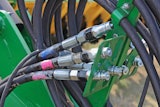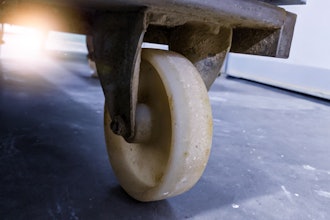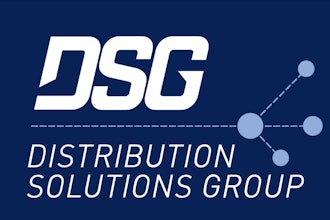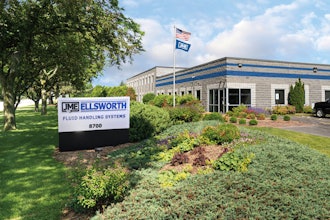Georgia Foley has spent a lifetime in and around the construction and industrial distribution business. When her father helped create the Specialty Tools & Fasteners Distributors Association—better known as STAFDA—Foley was enlisted to become the trade organization’s first employee, helping out between middle school homework assignments.
Years later, Foley serves in the role her dad originated at the top of the organization. Officially, she is the CEO of STAFDA. She sees her role quite differently, though. Foley spoke to Industrial Distribution about her history with STAFDA, her approach to leadership, and the challenges and opportunities ahead in the distribution business.
Industrial Distribution: Let’s start by digging into the background of STAFDA. What can you tell us about the group’s origins?
Georgia Foley: STAFDA was started back in 1977 by 18 distributors who knew each other through a common thread, which was my father, Morrie Halvorsen. All of them were looking for an organization to bring distributors and manufacturers together in the construction and industrial channel.
They bought the name Specialty Tools and Fasteners Distributors Association, because, for the most part, they were construction fastener distributors, although they represented a lot of other markets and channels. But, after they bought the name, they didn’t know what to do next.
My father had finished 23 years as vice president of sales and marketing for Milwaukee Electric Tool, in Brookfield, Wisconsin, and then he accepted a position with ITT Phillips Red Head, which was based out of Michigan City, Indiana. He commuted from our home to Michigan City for four years and wanted to get back to the area. He went to his 18 distributors and said “I’m going to take on STAFDA, on a 100 percent commission basis, because I see the potential for this group, and I’m going to grow it.”
It started in the basement of our house. I was his first employee at the ripe age of 13. He had countless industry contacts and quickly began building the organization. Today we’ve got nearly 2,500 members. We’ve gone from being a primarily domestic association to an international one with more than 70 programs and services. There has been tremendous growth within the distribution association community.
ID: How do you approach your role as CEO of STAFDA?
GF: I don’t see myself as a CEO. To me, the CEOs of STAFDA are the members who belong to this organization—I’m merely the caretaker. It’s up to me to offer them quality services and programs through education, and deliver them a high-end convention and trade show every year. Our annual meeting attracts the best and brightest, not only in North America, but also globally. It’s an event with educational programs led by business experts, and where our distributors and rep agents can make new contacts, strengthen relationships, and find new lines or products. I see my job as being STAFDA’s “CEO Caretaker.”
ID: What is it like to have literally grown up with this organization?
GF: One of the great things about STAFDA is that the majority of members, particularly the distributors, are still family owned businesses, whether it’s a son or daughter, cousins, in-laws or other relatives. Most are in their second to fourth generation, and a lot of the people who are in the position of CEOs or presidents of those companies are people I grew up with. We were the kids running around the STAFDA convention when our parents were attending meetings.
After I graduated college—and even when I was in college—I always went to every STAFDA convention. I worked the registration desk, my dad had me do whatever needed to be done. I did that through junior high school and high school as well.
After college, I managed an association in the trade show industry for seven years. When STAFDA went from a table top format to a trade show, in the early 1990s, my dad would ask me trade show-related questions over the dinner table. I never thought I’d end up working for my father, but he brought me on in August ‘94. I took over the member services area and one of my duties was to cultivate and expand STAFDA’s trade show.
Prior to joining STAFDA in 1994, I was managing the Exhibit Designers & Producers Association. I learned the trade show industry literally from the dock up. I spent a lot of quality time on the dock at McCormick Place, Javits, and a lot of the other convention centers, seeing how freight was delivered, moved to the show floor, assembled, and then disassembled after the show. I also made some industry contacts who I can still call on today. I’m very fortunate I had that experience, and I was able to bring that with me to STAFDA.
ID: Does your background make it easier for you to relate to the challenges family-owned business are facing?
GF: I certainly hope so. Associations are no longer regarded as as a “good old boys club.” That image went away in the 1980s. Associations today are run like a business. We have the same challenges as our members, whether it’s finding quality employees, dealing with healthcare issues, or challenged with mergers and acquisitions. An association truly is a business, and I can empathize with what our members are going through.
ID: How do you shape the education programs and other offerings of STAFDA?
GF: We’ve got a very active membership, so many of our services are based on member input. We don’t operate in a vacuum and try to come up with ideas. It’s input from our members which determine many of our services.
This year, we’re offering a series of outside sales workshops with Paul Reilly. A few years ago, Paul conducted a series of inside sales workshops for us. These workshops stem from member comments, it’s an inverted pyramid. We've got the members at the top, and it funnels down to our office, and we meet those needs.
ID: What are some of the leadership challenges you see in the field right now?
GF: One of the biggest issues is that our industry is graying out. There are a lot of transitions going on right now within company leadership, whether they’re selling out to a regional player, making a quiet acquisition to expand their footprint, or transitioning it onto the next generation. The quickening of mergers and acquisitions the past 12 months is also a challenge as the industry continues to consolidate.
ID: Generational transitions are always tough, but are there unique challenges to the switch in the current era?
GF: Technology has changed the outlook for a lot of younger people who don’t necessarily want to work for their family’s business. More Millenials are earning advanced degrees and finding their own career, rather than joining the family business.
In addition, it’s difficult to attract many college students to join a family business. They want to graduate and work for Fastenal, Grainger, or another big player.
ID: When you survey the field, what are some of the big opportunities right now?
GF: I don’t want to be redundant, but technology will continue to change the way our members do business: how they make deliveries, how they manage internal operations, how they handle social media.
Everyone cites Amazon as the game changer in nearly all industries. No one’s ever going to out-Amazon Amazon, but watching them and their innovations, then thinking about how to replicate the best of them to better serve customers, is one way to keep up with Amazon.
What I love about our industry is that it’s ever-changing. Even if you see the regional powerhouses flexing their muscles or companies selling out to them, it’s going to keep the industry pot stirred. The smaller independent distributor will adopt the same philosophies as the online players or the national distributors. STAFDA members are always on the move, always ahead of the curve, and one step ahead of what the customer wants or demands.
ID: The Amazon effect is discussed quite a bit in the industry. How do you see distributors responding to that challenge?
GF: At STAFDA’s founding, in 1977, Hilti was the major threat. Then big box stores became the enemy, and later it was Fastenal and Grainger and their pop up stores. And today, it’s all M&As and how they’re changing the landscape. When you look at all the threats that have been out there the last 40 years, our members have consistently figured out how to size them up and devise a way to work around them in order to remain profitable and successful. I don’t know what threats are coming down the road, but based on past history, I believe STAFDA members are fully capable of handling them.
More information about STAFDA is available at the organization’s website.
A version of this article appears in the March 2019 issue of Industrial Distribution.























